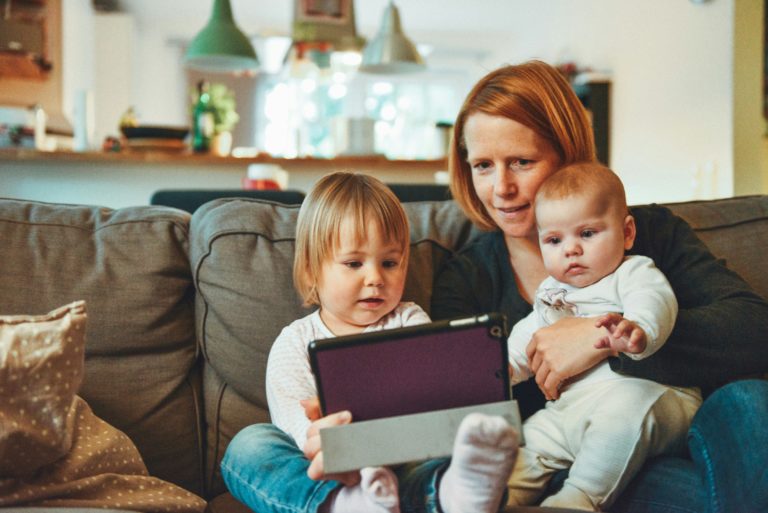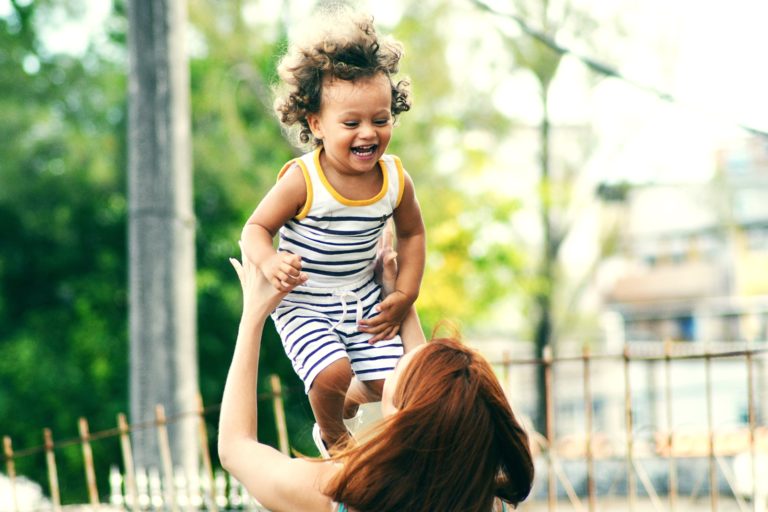Beginner’s Guide to Baby Carriers & Babywearing: Benefits, Safety Tips, How-To

6 minute read
Ask any parent what their favorite baby product is…and you’ll most likely hear the answer “our baby carrier!” That’s because even though your baby’s favorite place is in your arms, it may be difficult to tote your little one around all day and get anything else done!
That’s where babywearing can be a lifesaver. Babywearing is great for both you and your baby for many reasons – including bonding, convenience and safety. But how do you know if it’s right for you?
Read on to learn everything you need to know to get started with babywearing!
And if you’d prefer to learn in person, we offer an amazing Babywearing Basics class for parents. Come by and learn about the different types of carriers and which might be a good fit for your family. We’ll have several different carriers available for you to try, too!
What is Baby Wearing?
Have you seen parents out around town carrying a baby that’s strapped to their chest or back? That’s baby wearing!
By using a wrap or other device, baby wearing allows you to carry your baby while keeping your hands free for other tasks.
And did you know that this practice has been around for half a million years (Sapiens)? Crazy right? Humans began fashioning baby carriers out of animal skins, plants, and leather cords so that they could wear their babies while they foraged for food or moved to a safer resting place.
Today the practice continues — bringing the convenience of hands-free activities while still keeping your baby close during those early months.
Benefits of Baby Wearing
The primary benefit of baby wearing is a simple one: convenience. Using a baby carrier allows you to get things done around the house while knowing if your baby is safe and healthy. You can also go more places outside the home with ease (think unpaved hiking trails, places with stairs, crowded airports, congested stadiums).
But there are several additional benefits to using a baby carrier that you don’t want to miss.
- Baby wearing encourages chest/breastfeeding. For parents that want to nurse their baby, having your little one close to your chest will make breastfeeding more convenient. You can even nurse in many baby carriers!
You’ll also be able to more quickly notice your baby’s hunger cues — allowing you to feed your baby before they begin to cry. This leads to more confident parents and happier babies!
- Carried babies cry less. Carrying your baby for at least 3 hours a day can reduce crying. One study showed that when babies are at their peak fussiness — around 6 weeks — carried babies cried and fussed 43% less overall, and 51% less during the evening hours (Pediatrics).
- Babies that are held close are healthier. Babies that are held close more often — especially with skin-to-skin contact — are better at regulating their breathing patterns, heart rate, temperature, and even sleep!
- Baby wearing helps prevent physical deformities. Wearing your baby in different positions can help to prevent a flat spot from developing on the back of their head due to sleeping on their back too often.
And carrying your baby — as opposed to them spending tons of time in a swing or bouncy seat — helps to prevent other possible cranium and spinal deformities.
When Can You Start Using a Baby Carrier?
You can start using a baby carrier as soon as your little one is born!
Some baby carriers are specific for newborns — they don’t need a newborn insert — and your baby will probably outgrow them by 12-15 months. While others are designed to “grow” with your baby through the toddler years — but you may need a specific newborn insert for those first few months.
Choosing which type simply depends on the needs of your baby and family!
Are Baby Carriers Safe?
A baby carrier or sling are safe ways to carry your baby — as long as you follow the device’s safety guidelines.
This is especially important when a baby is under 4 months of age, as their neck muscles aren’t fully developed (Mayo Clinic). They can’t control their heads very well, making it dangerous if they end up in a position where fabric is covering their nose and mouth.
Here’s an easy way to remember how to keep your baby safe. Any time your little one is in a baby carrier or sling, remember to use T.I.C.K.S. (Baby Sling Safety).
- T — Tight. The sling or carrier you use should be tight enough to keep your baby close to you.
- I — In view at all times. You should be able to see your baby’s face by simply glancing down.
- C — Close enough to kiss. Your baby’s head should be as close to your chin as possible.
- K — Keep chin off chest. You should be able to fit at least a finger between your baby’s chin and chest.
- S — Supported back. Your baby’s back should be supported so that their tummy and chest aren’t slumped against you.
You’ll also want to be mindful of the proper positioning for your baby’s legs to prevent hip dysplasia. Their knees should always be higher than their bottom (see the figure below for reference). Keep in mind that newborns can also be held in a cradle position and should NOT use forward facing carriers.
Incorrect Positioning: Proper Positioning:
And when using a baby carrier or sling, make sure to:
- Thoroughly read the carrier/sling’s instructions. Remember to double check the device’s minimum and maximum weight guidelines.
- Keep your baby’s airways unobstructed. Make sure your baby’s face is visible at all times. Keep any fabric from covering their mouth or nose.
- Be careful when bending. Bend at your knees, rather than your waist. This will help to keep your baby in the proper position in their carrier/sling.
- Be mindful of wears and tears. Keep an eye on the condition of your carrier/sling, checking the seams and fasteners for tears or over-wearing.
Pro Tip: Practice putting your baby carrier/sling on without your baby first to get used to it. And then, when trying it the first few times with your baby, make sure your partner or a friend is close by as a “spotter.” Stand near a soft surface or close to the ground until you’re comfortable putting on your baby.
Types of Baby Carriers
Let’s take a look at the four main types of baby carriers.
- Sling. These are one long piece of sturdy fabric that wraps across one shoulder and your torso. They create a “pouch” for your little one to sit in. Slings come in many types of fabrics and may have a ring that’s adjustable. These are great for newborns as they can nestle into the fabric. But they may be a bit harder to wear for longer periods of time as they don’t distribute your baby’s weight evenly.
- Babywearing wrap. These wraps are super versatile! They are made from a super-long piece of cloth that wraps around your body — both shoulders and your torso — to create a carrier. Most are inexpensive and come in a one-size-fits-all which is great for adjusting to different body types. Newborns love wraps as they mimic the feeling of the womb. Note that they can take a little practice to get the hang of!
- Soft-structured carrier. Designed to be worn similar to a backpack, these carriers are softly padded and sewn into a seat with shoulder straps and buckles to adjust the fit. They offer great support — especially for toddlers — and are perfect if you want to carry your baby for long stretches or outdoor activities.
- Hybrid. These are a combination of wraps and soft-structured carriers. They are great for parents that want a baby carrier that‘s comfortable and easy to wear. But, it can be difficult to fit all body types.
How Long to Let Your Baby Sleep in a Carrier
The simple answer? As long as you both want! If your baby has the proper positioning, you can wear them for as long as you’d like throughout the day. Just make sure you’re also comfortable and have the proper back support.
What baby carrier is right for you?
There are SO many baby carrier options out there. That’s why we’ve hand-selected our favorites and offer them in the Babies in Bloom Boutique. It’s easy to shop online to pick out the baby carrier that works best for you!
If you’re not sure which type of baby carrier will work best for you, your baby, and your lifestyle, stop by the Babies in Bloom Boutique! We’d love to show you our baby carriers and help you try them on to see which you like best.
Schedule a Babywearing Consultation!
We have Certified Babywearing Educators on our team (who have received specialized training and certification from the Center for Babywearing Studies) that would love to help you get fitted for the perfect baby carrier.
By setting up an appointment with a Certified Babywearing Educator, you’ll get our undivided attention, as well as all the information you need to know that your baby is being worn correctly and safely.
We look forward to helping you “carry on!” Call 760-940-2229 to make an appointment today!






